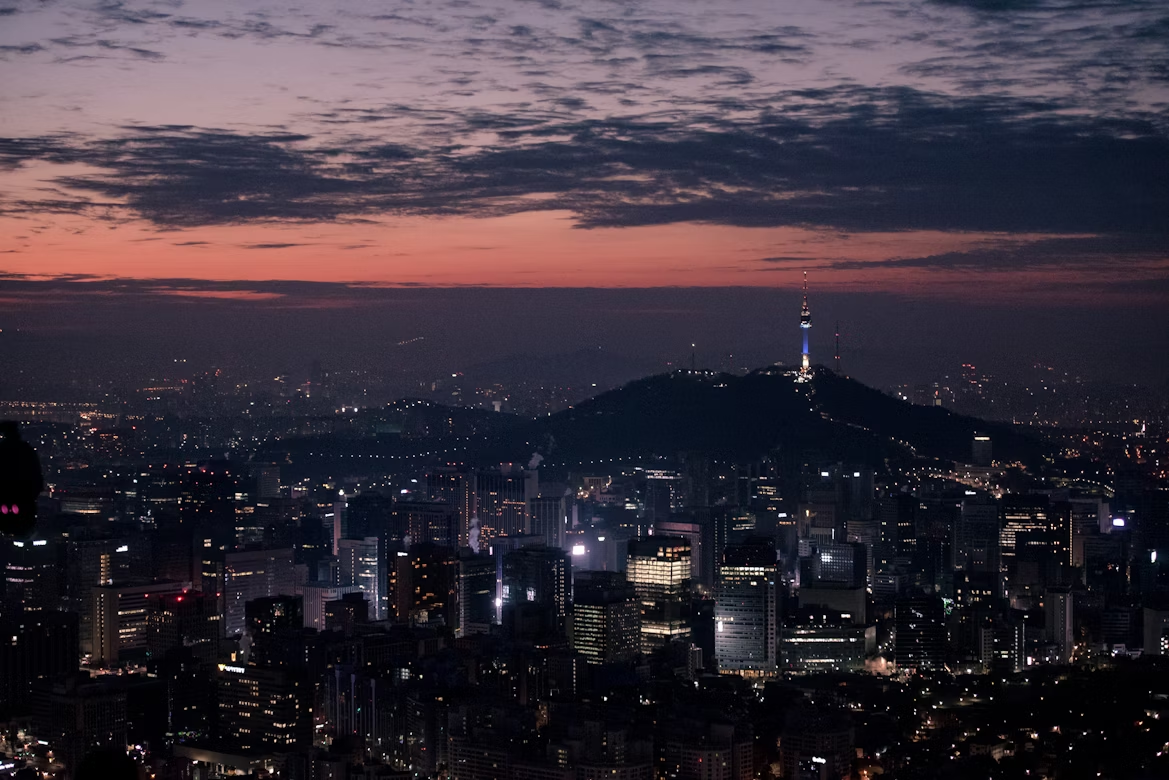The best time to visit South Korea depends on what you want to experience—cherry blossoms in spring, vibrant autumn foliage, or snow-covered temples in winter. This East Asian gem experiences all four seasons, each offering something unique for travelers, from cultural festivals to seasonal street foods.
This guide explores South Korea’s seasons, their pros and cons, and the best times to enjoy K-pop concerts, historical palaces, or mountain hikes. You’ll also discover when flights are most affordable and how to avoid crowds while making the most of your Korean adventure.
What is the Best Time to Visit South Korea?
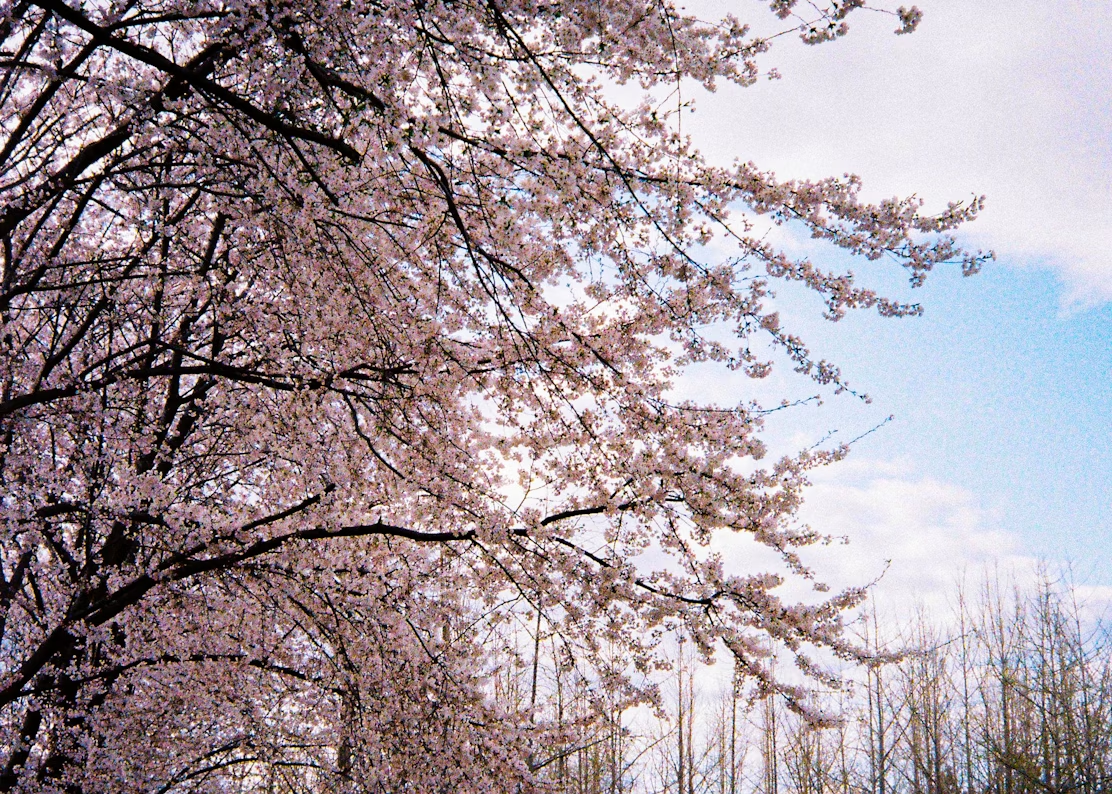
The best time to visit South Korea is from April to June and September to November. These months offer pleasant temperatures, low rainfall, and stunning natural scenery—from cherry blossoms in spring to fiery foliage in autumn. They’re perfect for exploring palaces, hiking trails, traditional villages, and vibrant cityscapes.
April and May bring colorful blooms and mild weather conditions in South Korea, making them the best time for outdoor activities in South Korea. October and early November offer crisp air, clear skies, and some of Asia’s most breathtaking fall colors, especially in mountainous regions like Seoraksan and Naejangsan.
|
Month |
Season |
Temperature Range (°C) |
Chance of Rain |
Month-wise Rating |
|
January |
Winter |
1.1°C – -6.1°C |
10% |
Worst |
|
February |
Winter |
4.4°C – -3.3°C |
12% |
Worst |
|
March |
Early Spring |
10.6°C – 0.6°C |
25% |
Shoulder |
|
April |
Spring |
18.3°C – 9.4°C |
20% |
Best |
|
May |
Spring |
23.9°C – 14.4°C |
25% |
Best |
|
June |
Early Summer |
27.2°C – 18.9°C |
35% |
Shoulder |
|
July |
Summer (Monsoon) |
29.4°C – 23.3°C |
60% |
Worst |
|
August |
Summer (Monsoon) |
30.0°C – 24.4°C |
65% |
Worst |
|
September |
Autumn |
26.7°C – 19.4°C |
30% |
Shoulder |
|
October |
Autumn |
20.6°C – 12.8°C |
18% |
Best |
|
November |
Late Autumn |
13.9°C – 4.4°C |
15% |
Shoulder |
|
December |
Winter |
4.4°C – -3.3°C |
12% |
Worst |
Source: Korea Meteorological Administration and Weather Spark
Suggested Read: South Korea Visa for Indians
South Korea During Different Seasons
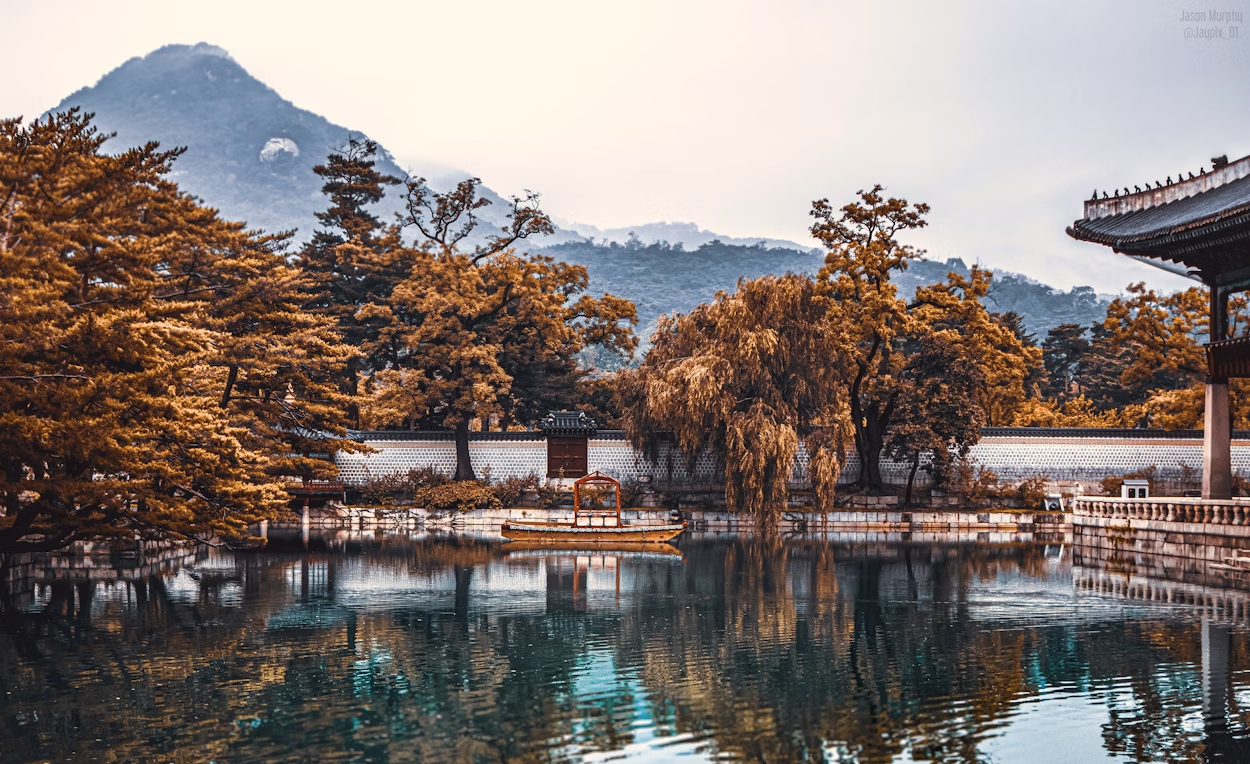
South Korea experiences four sharply defined seasons, each offering distinct weather patterns, cultural events, and natural beauty. From snowy mountains in winter to blooming cherry blossoms in spring, the country’s climate plays a key role in shaping your travel experience. Whether you’re chasing fall foliage or summer festivals, understanding each season will help you plan the perfect trip.
Winter (December to February)
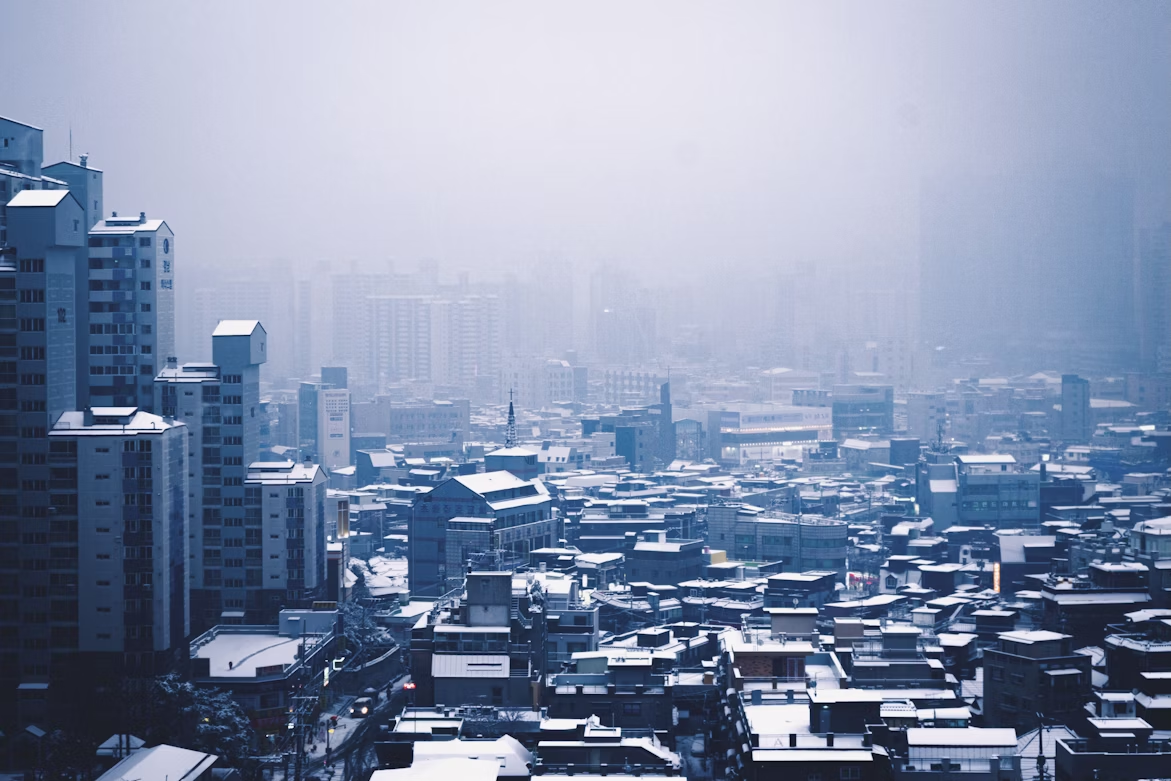
Weather: South Korea’s winter is dry, cold, and often snowy, especially in the north and mountainous regions. Cities like Seoul experience freezing temperatures with crisp, clear skies. It’s the best time for winter sports, ice fishing festivals, and cozy indoor experiences like jjimjilbang (Korean spas).
Temperature:
- December: 4.4°C high / -3.3°C low
- January: 1.1°C high / -6.1°C low
- February: 4.4°C high / -3.3°C low
Visitor Numbers: Visitor numbers peak at ski resorts and popular New Year destinations but remain moderate in cities. Travel is less hectic compared to the cherry blossom and autumn foliage seasons.
Events and Festivals:
- Hwacheon Sancheoneo Ice Festival: Held in January in Gangwon-do, this ice fishing festival lets visitors catch trout from frozen rivers, followed by sledding and snow sculptures.
- Pyeongchang Trout Festival: Another top winter event, known for snow rafting, fishing, and BBQ areas.
- Seollal (Lunar New Year): Late January or February. Families honor ancestors, and major palaces in Seoul host traditional ceremonies with free entry in hanbok (Korean attire).
- Taebaeksan Snow Festival: Held in Taebaek city, this festival features massive snow and ice sculptures, snow slide zones, light displays, and mountain trekking trails lit up at night.
Why You Should Visit Now: Perfect for snow lovers and culture seekers. The lack of humidity makes it pleasant for walking tours, temple visits, and museum hopping. It’s also shopping season, with major winter sales in Seoul’s districts like Myeongdong and Dongdaemun.
Seasonal Dishes & Drinks:
- Tteokguk (rice cake soup): A traditional New Year’s dish believed to bring good luck.
- Hotteok (sweet pancakes) and odeng (fish cake skewers): Popular winter street snacks.
- Makgeolli (rice wine): Especially warming when served warm in cold weather.
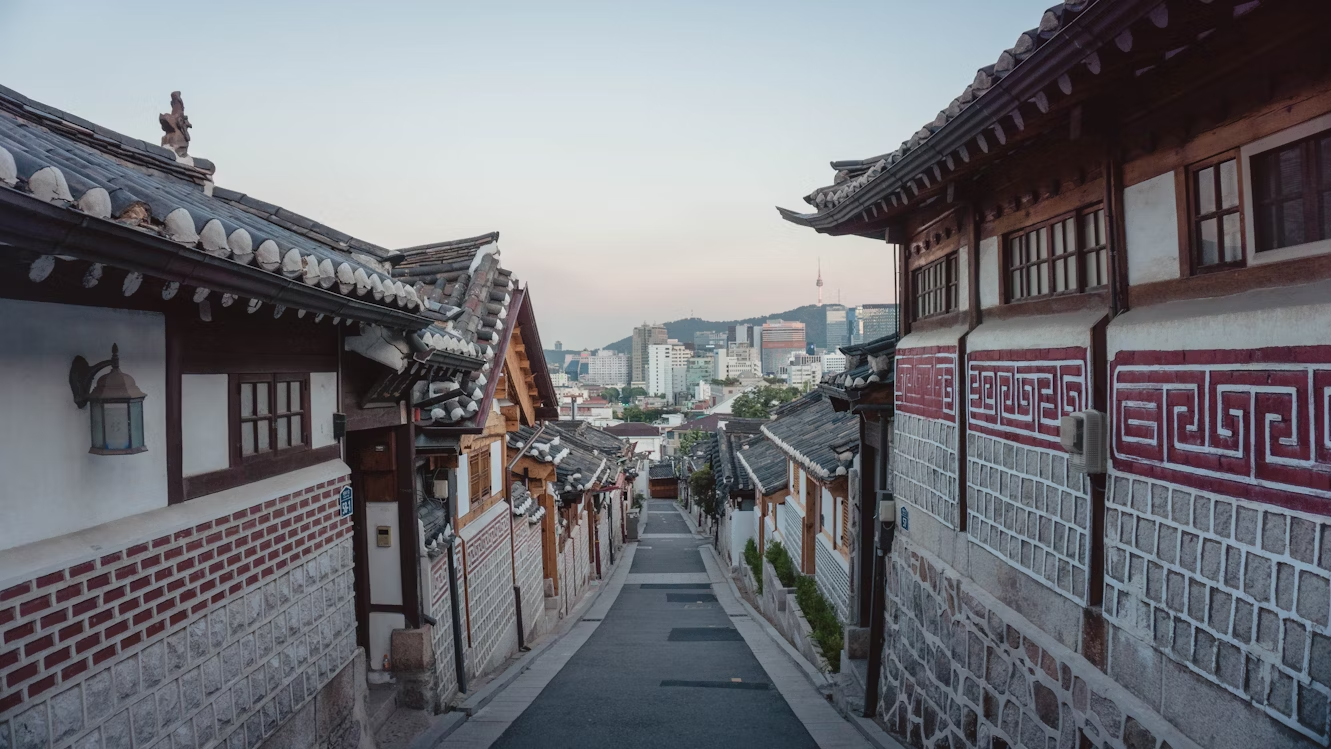
Places to Visit:
- Nami Island: Just a short trip from Seoul, this scenic island becomes a winter wonderland with snow-covered tree-lined roads, frozen rivers, and cozy cafes. Popular with couples and photographers, it offers peaceful walks and even sled rentals during snowfall.
- Vivaldi Park Ski World: Located only 1.5 hours from Seoul, this is one of Korea’s most accessible and modern ski resorts. Ideal for families and beginners, it offers skiing, snowboarding, sledding, and even indoor waterparks to warm up afterward.
- Jogyesa Temple: This serene temple in downtown Seoul is especially beautiful in winter with lantern-lit paths, snow-dusted rooftops, and quiet corners for reflection. Visit around Seollal to witness traditional rituals and enjoy free cultural programs.
- Seoul Plaza Ice Rink: In front of City Hall, this open-air skating rink is a winter staple. Surrounded by city lights and festive decor, it’s great for families, couples, and anyone who wants to enjoy ice skating without leaving central Seoul.
- Garden of Morning Calm (Lighting Festival): Located in Gapyeong, this winter illumination festival transforms the gardens into a glowing dreamscape of over 30,000 lights spread across themed zones. It’s especially enchanting when blanketed in snow, perfect for a romantic winter evening.
- Dongdaemun Design Plaza (DDP): While mostly known for its futuristic architecture, DDP hosts winter light installations, pop-up art exhibits, and nighttime markets during the colder months. It’s an indoor-outdoor hybrid spot ideal for both sightseeing and staying warm.
What to Pack:
- Thermal base layers and heavy coats
- Wool sweaters, gloves, and scarves
- Moisturizer and lip balm (it gets dry!)
- Warm socks and waterproof boots
Trip Planning Considerations:
- Outdoor: Great for skiing, snowboarding, and scenic walks in snow-draped villages.
- Indoor: Cozy cafés, museums, jjimjilbangs, and shopping centers.
Pro Tips:
- Book ski resort stays early—weekends fill up fast in winter.
- Wear layers to adjust between warm interiors and freezing outdoors.
- Check palace opening hours—some close early in winter.
Ideal for: Skiers, culture lovers, couples, photographers
Suggested Read: South Korea Visa Extension for Indian Travelers
Spring (March to May)

Weather: Spring in South Korea starts chilly but quickly warms up by April. The highlight of the season is the cherry blossom bloom, peaking in late March or early April, depending on location. Skies are generally clear, and parks burst into color with flowers.
Temperature:
- March: 10.6°C high / 0.6°C low
- April: 18.3°C high / 9.4°C low
- May: 23.9°C high / 14.4°C low
Visitor Numbers: High during the cherry blossom season. Expect large crowds at popular viewing spots, though other parts of the country remain moderately busy.
Events and Festivals:
- Jinhae Cherry Blossom Festival: South Korea’s most iconic spring festival, held in early April. Famous for its romantic tree-lined railway tracks and street performances.
- Yeouido Spring Flower Festival: Held in Seoul, showcasing over 1,400 cherry trees along the Han River.
- Boseong Green Tea Festival: Takes place in May at lush tea plantations in Jeollanam-do, featuring tastings and DIY tea making.
Why You Should Visit Now: Spring is Korea at its prettiest. The weather is mild, and festivals and events in South Korea are in full bloom. Whether you’re strolling through palace gardens or countryside villages, the scenery is postcard-perfect.
Seasonal Dishes & Drinks:
- Cherry blossom-themed desserts and lattes: Widely available in cafés.
- Spring vegetables and bibimbap: Seasonal ingredients shine in temple cuisine.
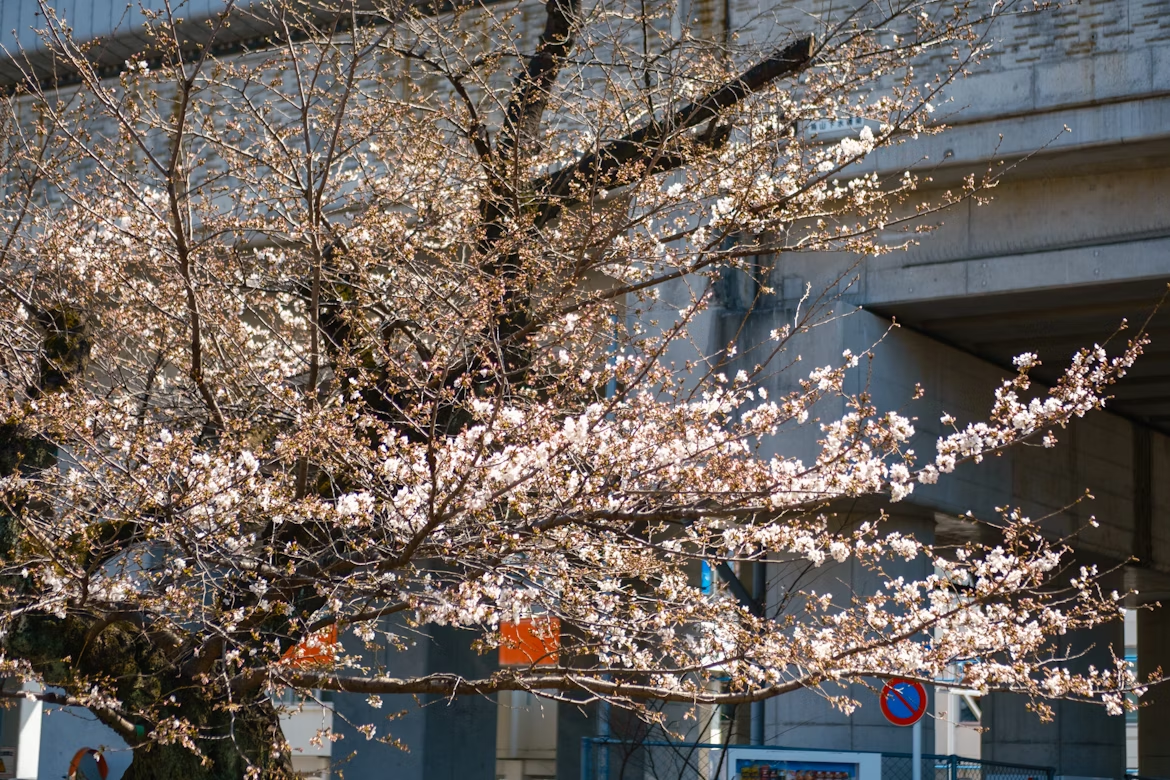
Places to Visit:
- Gyeongbokgung Palace: Gorgeous cherry trees line the palace grounds, creating a beautiful contrast against the traditional Korean architecture. Springtime ceremonies and hanbok rentals make it even more picturesque for photos and cultural experiences.
- Seokchon Lake: Famous for its tunnel of pink cherry blossoms mirrored on the lake’s calm surface. The lake loop is a favorite among locals for spring strolls, photo ops, and seasonal food stalls.
- Jeju Island: Offers some of the earliest cherry blossom blooms in South Korea, often in late March. The island is also known for vibrant spring flower fields, including canola blossoms, creating stunning backdrops for scenic drives and bike rides.
- Namsan Park: Ideal for a scenic spring hike with panoramic city views. Cherry blossoms bloom along walking trails leading up to N Seoul Tower, offering picture-perfect resting spots and picnic areas.
- Naejangsan National Park: While most known for autumn foliage, it’s also fantastic for late-spring hikes. The park’s mountainous trails are covered in colorful azaleas and fresh greenery, making it a peaceful retreat from city crowds.
What to Pack:
- Light sweaters, jackets, and scarves
- Allergy medicine (pollen can be high)
- Sunscreen and sunglasses
- Comfortable shoes for walking tours
Trip Planning Considerations:
- Outdoor: Best time for palace visits, hiking, and cherry blossom tours.
- Indoor: Art galleries, hanbok rentals with indoor photo spots, cafés.
Pro Tips:
- Book cherry blossom tours and hotels at least 2 months in advance.
- Check bloom forecasts—they change slightly each year.
- Arrive early in the morning to avoid crowds at popular parks.
Ideal for: Couples, photographers, solo travelers, nature lovers
Suggested Read: South Korea With Kids: Your Gateway to K-Pop Dreams and Ancient Wonders
Summer (June to August)
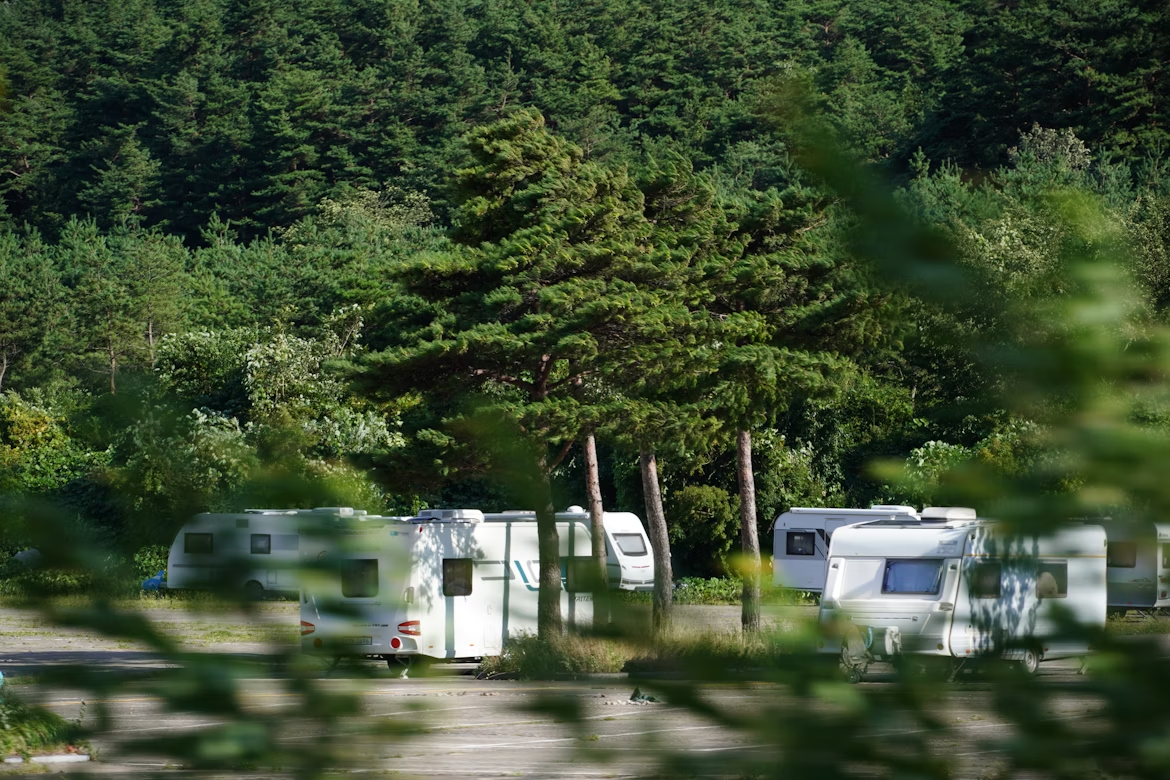
Weather: Summer in South Korea is hot, humid, and marks the monsoon season (called jangma), particularly in July. While June can still be comfortable, July and August bring frequent downpours and high humidity levels. It’s also typhoon season, especially in coastal and southern regions. However, summer is when Korea comes alive with beach trips, water parks, and colorful festivals.
Temperature:
- June: 27.2°C high / 18.9°C low
- July: 29.4°C high / 23.3°C low
- August: 30.0°C high / 24.4°C low
Visitor Numbers: Tourist numbers dip slightly due to the heat and rain, making this a budget-friendly time to visit. Locals head to beaches and indoor attractions to escape the humidity.
Events and Festivals:
- Boryeong Mud Festival: Held in July, this iconic event turns the Daecheon beach into a muddy playground with slides, music, and beauty treatments.
- Busan Sea Festival: A summer highlight in early August with beach concerts, fireworks, and water sports.
- Water Gun Festival in Sinchon (Seoul): Street-wide water battles with DJs, costumes, and foam parties, especially popular with young travelers.
- Bucheon International Fantastic Film Festival (BiFan): Korea’s largest genre film festival, held in July.
Why You Should Visit Now: If you enjoy nightlife, beach fun, and indoor attractions like aquariums and cafés, summer is a fun time to visit. While it’s wet outside, the energy is high inside, with sales, events, and nightlife in full swing.
Seasonal Dishes & Drinks:
- Naengmyeon (cold buckwheat noodles): The ultimate summer refresher, often served in icy broth.
- Patbingsu (shaved ice dessert): Topped with sweet red beans, fruit, or condensed milk.
- Samgyetang (ginseng chicken soup): Traditionally eaten to fight the heat with heat.
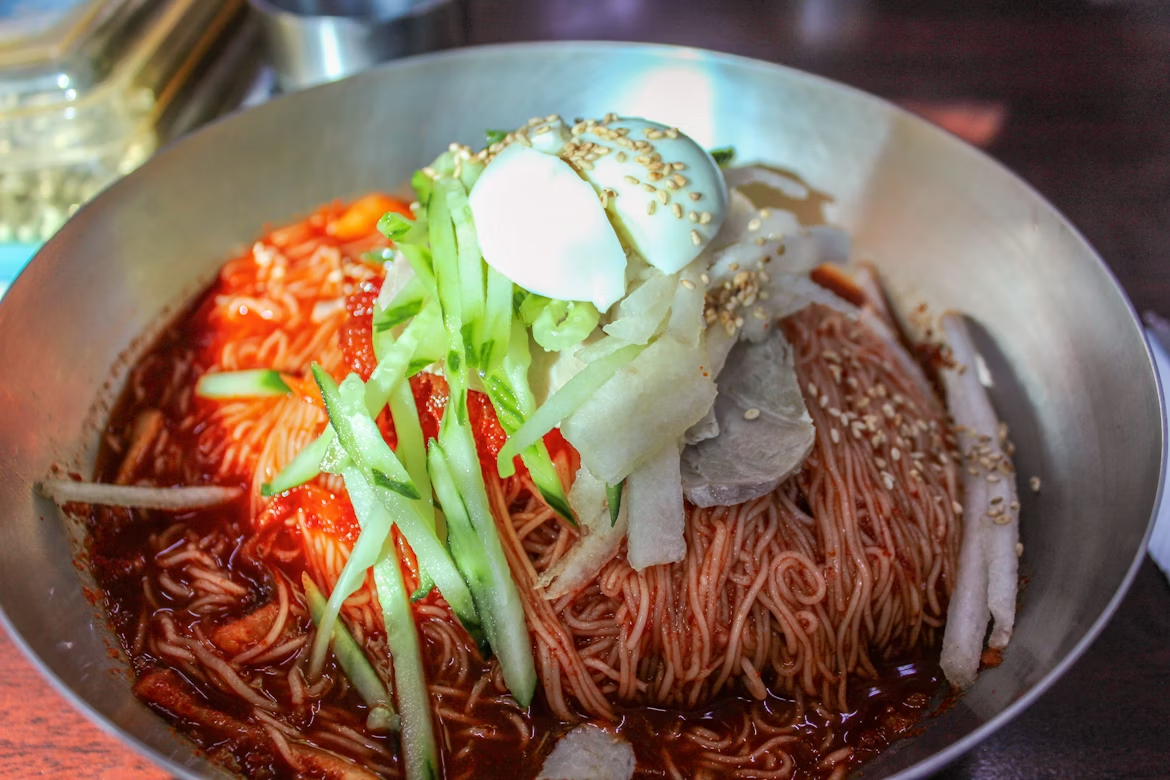
Places to Visit:
- Haeundae Beach (Busan): Korea’s most popular beach, Haeundae is lively even in summer with its long sandy shorelines, beachfront cafés, and evening night markets. Despite the heat, the ocean breeze and occasional fireworks festivals make it a fun summer destination for families and couples.
- COEX Aquarium & Starfield Library: Located in Seoul’s Gangnam district, these air-conditioned indoor attractions are perfect for escaping the summer heat or monsoon rains. The COEX Aquarium features themed marine zones, while Starfield Library offers a quiet, photogenic escape with towering bookshelves and modern seating.
- Gyeongju: Known as Korea’s “museum without walls,” Gyeongju is less crowded during the summer months. Explore UNESCO-listed temples, ancient tombs, and royal ruins in relative peace. Rent a bike to tour around historical parks and visit Bulguksa Temple under lush greenery.
- Seoraksan Cable Car: Even during Korea’s humid summer, this cable car ride offers a refreshing change with panoramic views of fog-draped granite peaks, green valleys, and mountain temples. If the weather clears after rain, the scenery becomes especially mystical.
- Danyang Paragliding & Caves: Danyang is famous for its dramatic landscapes and outdoor adventures. You can paraglide over the Namhangang River for unforgettable aerial views, or head underground to explore cool limestone caves like Gosu Cave, a perfect refuge on hot or rainy days.
What to Pack:
- Light, breathable clothes like cotton T-shirts and shorts
- An umbrella or a rain poncho for monsoon showers
- Mosquito repellent and sunscreen
- Reusable water bottle and hand fan
Trip Planning Considerations:
- Outdoor: Visit beaches early or late in the day. Stay alert to weather updates if planning hikes or water activities.
- Indoor: Great time for shopping in Seoul’s mega malls, themed cafés, museums, and spas.
Pro Tips:
- Check typhoon forecasts and monsoon alerts via the Korea Meteorological Administration.
- Indoor attractions can get crowded on rainy days—arrive early.
- Wear waterproof footwear or quick-dry sandals to handle sudden showers.
Ideal for: Budget travelers, festival lovers, nightlife seekers, beachgoers
Suggested Read: South Korea Itinerary 7 Days – Your Complete Travel Guide
Autumn (September to November)
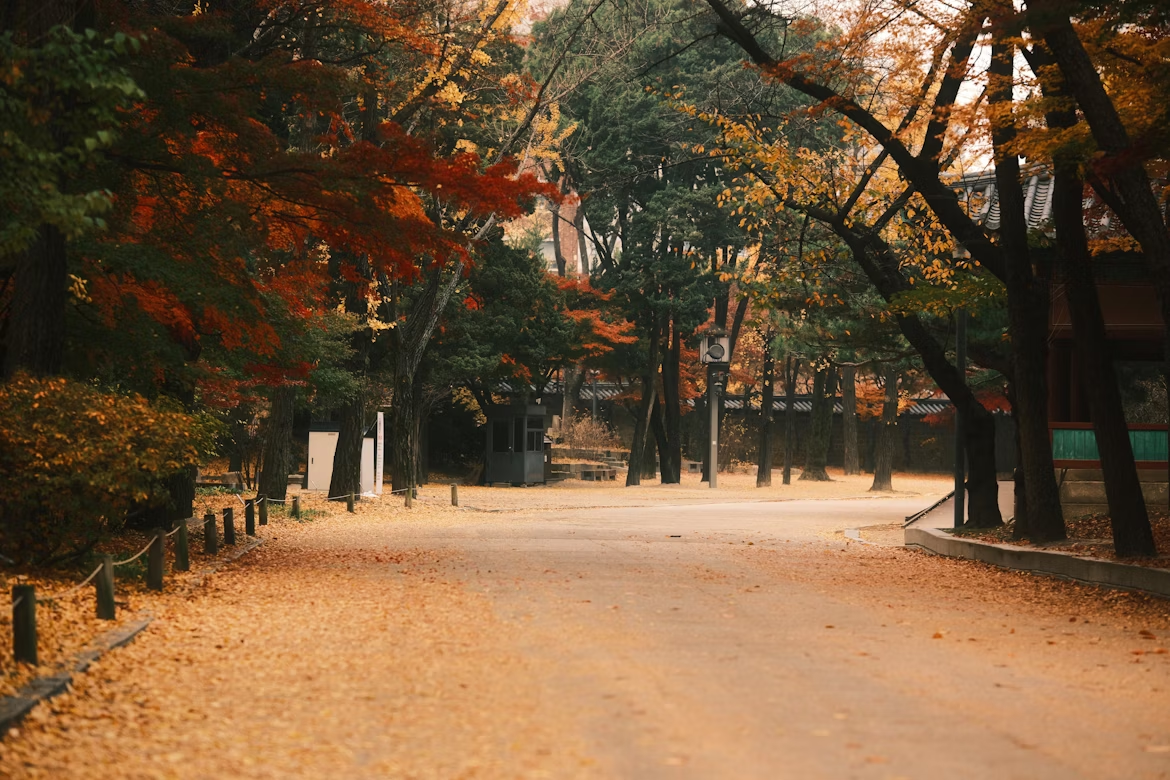
Weather: Autumn is widely considered the most beautiful season in South Korea. Rainfall drops, skies clear, and temperatures cool down steadily. The country’s mountains and national parks explode in brilliant shades of red, orange, and yellow from mid-October to early November.
Temperature:
- September: 26.7°C high / 19.4°C low
- October: 20.6°C high / 12.8°C low
- November: 13.9°C high / 4.4°C low
Visitor Numbers: This is a peak tourist season in South Korea, especially in late October when fall foliage is at its best. Book your accommodations early if traveling to popular leaf-peeping destinations like Seoraksan or Naejangsan.
Events and Festivals:
- Seoul Lantern Festival: Held in November along the Cheonggyecheon Stream, this lantern festival features beautiful themed lanterns.
- Andong Mask Dance Festival: Celebrates Korea’s traditional mask dance-drama (talchum) with performances, crafts, and parades.
- Jinju Namgang Yudeung Festival: A river lantern festival with glowing displays and cultural events.
- Korean Thanksgiving (Chuseok): Occurs in September or October. Families return home, and major palaces offer traditional programs.
Why You Should Visit Now: Autumn provides ideal conditions for city tours, countryside hikes, and cultural immersion. These are the best months for nature lovers in South Korea. Also, it is a good time for photographers. Air is clean, foliage is vivid, and every temple and trail looks picture-perfect.
Seasonal Dishes & Drinks:
- Songpyeon (rice cakes): Eaten during Chuseok, filled with sesame, chestnuts, or sweet beans.
- Grilled chestnuts and roasted sweet potatoes: Sold by street vendors as the weather cools.
- Persimmons: Fresh or dried (gotgam), they’re a classic autumn snack.

Places to Visit:
- Naejangsan National Park: Considered one of Korea’s most iconic fall foliage destinations, Naejangsan National Park bursts into a riot of red, orange, and gold during late October to early November.
- Seoraksan National Park: Known for its rugged granite peaks, cascading waterfalls, and sweeping valleys, Seoraksan becomes even more spectacular in autumn. From late September through October, the park transforms with vibrant fall foliage along its many trails.
- Gyeongbokgung Palace (Seoul): The grandeur of Gyeongbokgung Palace is accentuated in autumn by golden ginkgo trees and fiery maples that line the walkways and palace courtyards. The crisp air and clear skies create perfect conditions for wearing traditional hanbok and capturing striking seasonal photos with the historic architecture as a backdrop. Don’t miss the royal guard changing ceremony for a glimpse into Joseon-era traditions.
- Bulguksa Temple (Gyeongju): Nestled in the ancient capital of Gyeongju, Bulguksa Temple is surrounded by wooded hills that turn brilliant shades of red and yellow in autumn.
- Cheonggyecheon Stream (Seoul): Running through the heart of downtown Seoul, Cheonggyecheon is a restored stream flanked by walking paths, small waterfalls, and art installations. In autumn, it becomes a peaceful escape from the busy city, especially in the early evening when the breeze is cool and the golden light reflects off the water.
What to Pack:
- Long-sleeved tops and light jackets
- Comfortable shoes for walking or hiking
- A scarf or windbreaker for chilly evenings
- Sunglasses and a small daypack for excursions
Trip Planning Considerations:
- Outdoor: Autumn hikes, palace tours, foliage photography, cultural festivals.
- Indoor: Explore traditional houses, museums, and tea houses on cooler days.
Pro Tips:
- Book fall foliage tours or train tickets to national parks early.
- Visit popular temples early in the day to avoid peak crowds.
- Chuseok closures may affect restaurants and shops.
Ideal for: Photographers, hikers, families, couples, cultural travelers
Suggested Read: Explore Spring in South Korea
Shoulder Season in South Korea
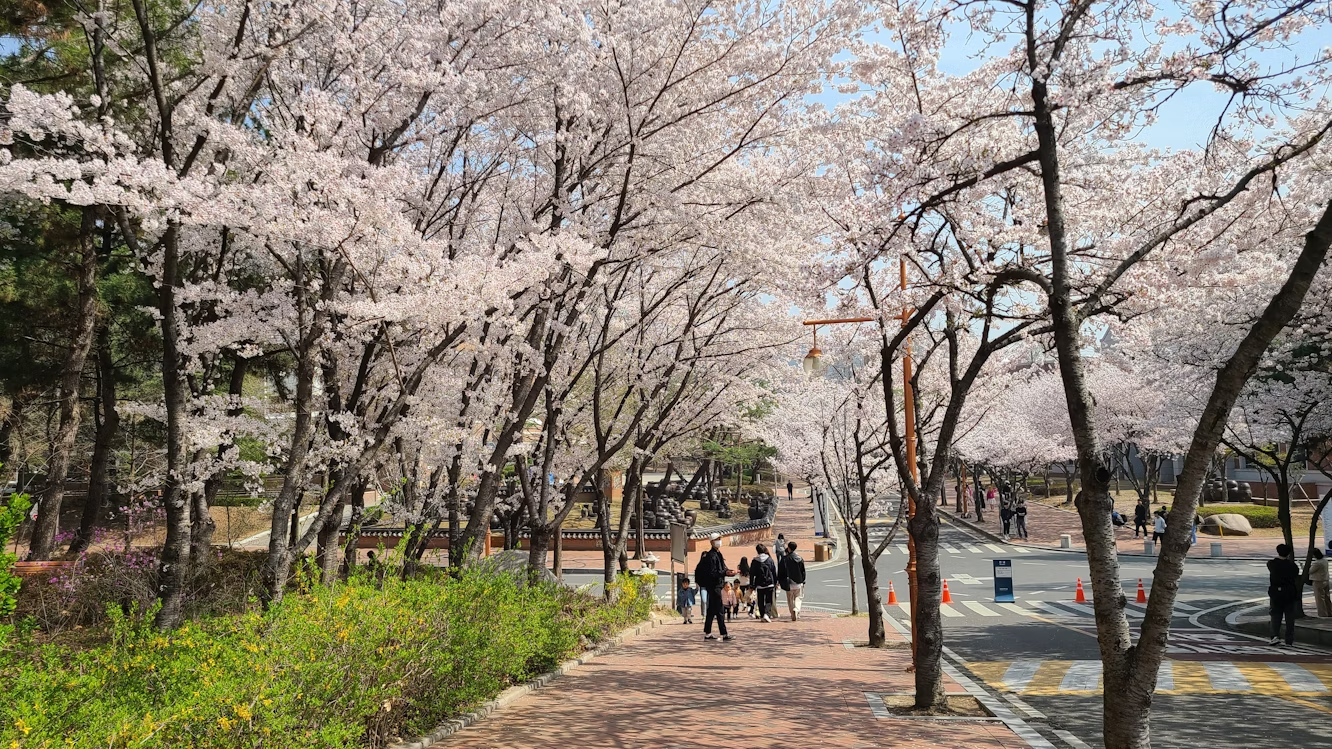
April to June and September to early October are considered the shoulder seasons in South Korea. These periods offer a sweet spot between extreme weather and peak tourist crowds. You’ll experience pleasant temperatures, colorful scenery, and moderate prices without sacrificing much in terms of comfort or cultural experiences.
Pros of going to South Korea during the shoulder season:
- Best months for sightseeing in South Korea
- Affordable flight and hotel rates compared to peak cherry blossom or fall foliage months
- Fewer tourists at palaces, museums, and cultural attractions
- Local festivals and seasonal foods are still in full swing
Cons of going to South Korea during the shoulder season:
- Late April and early May can bring sudden rain showers
- Yellow dust (hwangsa) from China may affect air quality in spring
- Some cherry blossom or autumn foliage sites may be past peak depending on timing
- Rural festivals may not align exactly with your travel dates
Suggested Read: Historical Places in South Korea
Cheapest Time to Visit South Korea
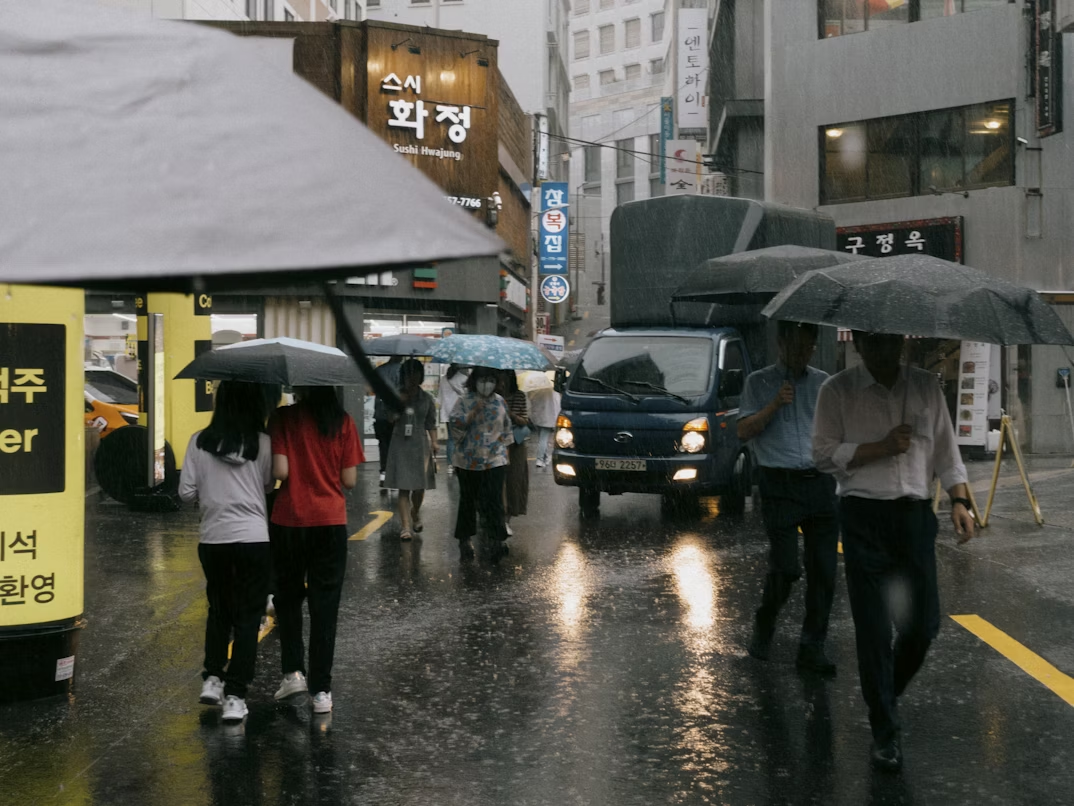
If you’re traveling on a budget, the budget-friendly months to visit South Korea are during the late summer months of July and August and the cold winter period from January to February. These are considered the months of off-season travel to South Korea due to either extreme heat with monsoon rains or freezing temperatures, but they offer significant savings on flights, accommodations, and tours.
Budget Tips:
- Book hotels and flights 2–3 months ahead for the best off-season deals
- Visit indoor attractions like museums, palaces, and cafés during rain or snow
- Use the Korea Tour Card for public transportation and discounts on tourist sites
- Shop during seasonal sales in January and August in districts like Myeong-dong or Dongdaemun
Suggested Read: How To Check Your South Korea Visa Status from India
Challenging Seasons for South Korea Travel
While South Korea is a year-round destination, some periods pose more challenges for tourists. The rainy monsoon season (mid-June to late July) and deep winter (late December to early February) are typically the most difficult times to visit.
Monsoon Season
This period brings intense humidity and frequent downpours, especially in southern and coastal regions. Sudden storms can lead to flash floods, transportation delays, and trail closures in mountainous areas.
Winter Extremes
Although scenic, the heart of winter (especially January) can be uncomfortably cold for some travelers. Urban areas experience freezing temperatures, and rural regions may face icy roads or snowfall disruptions. This season also sees shorter daylight hours and limited outdoor activity options unless you’re visiting for skiing or snowboarding.
Chuseok (Korean Thanksgiving)
Occurring in September or October, Chuseok is one of South Korea’s biggest holidays. While it’s a rich cultural experience, it comes with heavily booked transportation, closed shops, and crowded highways as locals travel to their hometowns. If you wish to enjoy a holiday season travel to South Korea, trains and buses should be booked well in advance if you’re traveling during this period.
Why You Might Avoid These Periods:
- Unpredictable weather during the monsoon season
- Sub-zero temperatures and icy conditions in winter
- Limited access to services during national holidays
- Inflated transport costs and crowds during Chuseok
Who Should Avoid It: First-time visitors, elderly travelers, families with young children, or those who prefer consistent weather and flexibility.
Suggested Read: Winter in South Korea


FAQs
1. What is the best month to visit South Korea?
The best months to visit South Korea are April (for cherry blossoms) and October (for autumn foliage). During these times, the weather is generally mild, the humidity is low, and the natural landscapes are stunning. You’ll also find a wide range of cultural events and local festivals that add charm to the experience. These months are ideal for hiking, temple visits, and outdoor street markets.
2. When is the cherry blossom season in South Korea?
Cherry blossom season usually starts in late March and peaks during the first week of April, though this varies by region. Jeju Island and Busan bloom earlier due to their southern location, while Seoul, Gyeongju, and the northern regions bloom later. It’s a short season, lasting only about one to two weeks per region, so timing your visit is key.
3. Is winter a good time to visit South Korea?
Yes, winter (December to February) is an excellent time to visit if you enjoy snowy landscapes, winter sports, or relaxing indoors in a jjimjilbang (Korean spa). Ski resorts like Vivaldi Park and Yongpyong are at their peak. You can also enjoy festive experiences like Seollal (Lunar New Year) and ice fishing festivals. Just be prepared for sub-zero temperatures in many areas.
4. When is the rainy season in South Korea?
South Korea’s monsoon season (jangma) generally lasts from mid-June to late July. This period is marked by frequent showers, cloudy skies, and high humidity. While travel is still possible, you may want to avoid planning outdoor-heavy itineraries like mountain hiking or island hopping. Cities like Seoul remain lively but can feel muggy during this time.
5. When to visit South Korea for fewer crowds?
The late winter months (January and February) and late summer (mid to late August) tend to have fewer tourists. These months are considered off-peak due to cold weather or summer heat and humidity. If you’re okay with bundling up or staying indoors, these are great months for budget-friendly travel and avoiding long lines at attractions.
6. Is it safe to visit South Korea during typhoon season?
Yes, South Korea is generally safe during typhoon season (August to early September), but coastal regions like Busan, Jeju, and Yeosu may be more affected. Keep an eye on weather forecasts, especially if you’re flying or taking ferries. Travel insurance and flexible booking options are recommended for this period.
7. What should I wear during spring or autumn in Korea?
Spring (March to May) and autumn (September to November) have comfortable temperatures but can shift suddenly. Pack layered outfits—light jackets, sweaters, long-sleeved shirts, and scarves. A small umbrella or light raincoat is useful in spring. These seasons are perfect for outdoor walks, so bring comfortable shoes for city tours and scenic hikes.
8. When to Find the Best Deals in South Korea?
The best travel deals in South Korea can typically be found during the off-peak seasons, especially in late winter (January to early February) and late summer (mid to late August). These periods see fewer tourists due to extreme cold or hot, humid weather, leading to discounted hotel rates, flight deals, and off-season promotions. Winter sales in shopping districts like Myeong-dong and Dongdaemun also offer great bargains on fashion and cosmetics. Additionally, booking 2–3 months in advance for spring and autumn can help you lock in better prices before peak season demand drives up costs.
9. How far in advance should I book for cherry blossom or fall foliage trips?
For the best time to visit South Korea, like cherry blossom season in late March–early April or fall foliage in mid-October–early November, it’s best to book flights, hotels, and tours at least 2 to 3 months in advance. Cities like Seoul, Busan, and Jeju fill up quickly with both local and international tourists. Early planning ensures better rates and ideal accommodation options.





